Remote Work: Benefits, Limitations, and Impact - Literature Review
VerifiedAdded on 2022/08/20
|10
|2867
|9
Literature Review
AI Summary
This literature review delves into the multifaceted aspects of remote working, exploring its benefits, limitations, and overall impact. The review highlights advantages such as reduced office overheads and improved employee retention, while also acknowledging the challenges, including potential for isolation and communication barriers. It examines the influence of remote work on office space design, emphasizing the shift towards collaborative environments. Furthermore, the review analyzes the role of employee engagement in remote settings, stressing the importance of communication and virtual interaction. The impact on employee performance, considering both increased productivity and potential distractions, is also discussed. Finally, the review addresses the environmental benefits of remote work, such as reduced carbon emissions and resource consumption. The literature also identifies gaps in current research, particularly concerning the limitations of remote working.
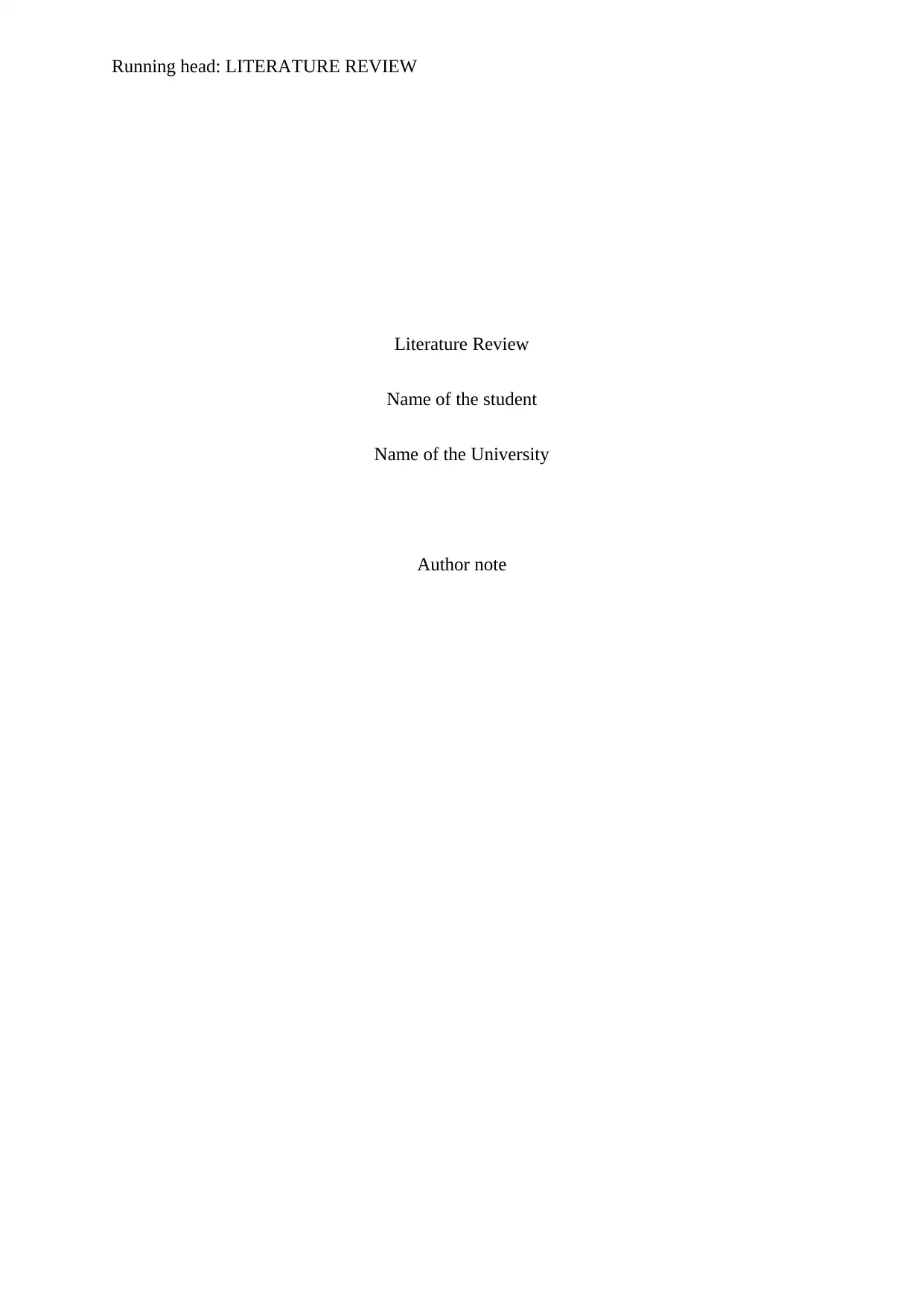
Running head: LITERATURE REVIEW
Literature Review
Name of the student
Name of the University
Author note
Literature Review
Name of the student
Name of the University
Author note
Paraphrase This Document
Need a fresh take? Get an instant paraphrase of this document with our AI Paraphraser
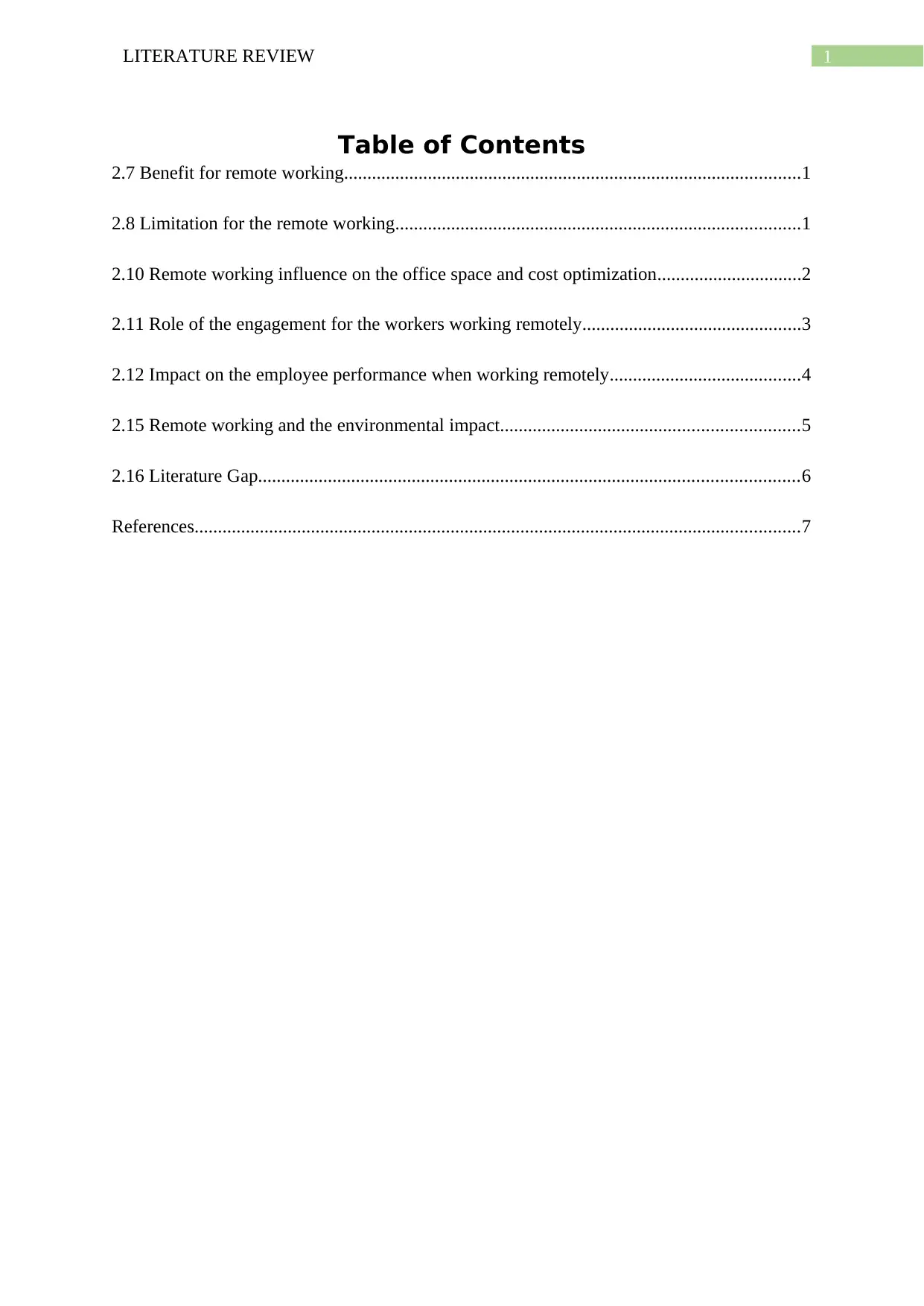
1LITERATURE REVIEW
Table of Contents
2.7 Benefit for remote working..................................................................................................1
2.8 Limitation for the remote working.......................................................................................1
2.10 Remote working influence on the office space and cost optimization...............................2
2.11 Role of the engagement for the workers working remotely...............................................3
2.12 Impact on the employee performance when working remotely.........................................4
2.15 Remote working and the environmental impact................................................................5
2.16 Literature Gap....................................................................................................................6
References..................................................................................................................................7
Table of Contents
2.7 Benefit for remote working..................................................................................................1
2.8 Limitation for the remote working.......................................................................................1
2.10 Remote working influence on the office space and cost optimization...............................2
2.11 Role of the engagement for the workers working remotely...............................................3
2.12 Impact on the employee performance when working remotely.........................................4
2.15 Remote working and the environmental impact................................................................5
2.16 Literature Gap....................................................................................................................6
References..................................................................................................................................7
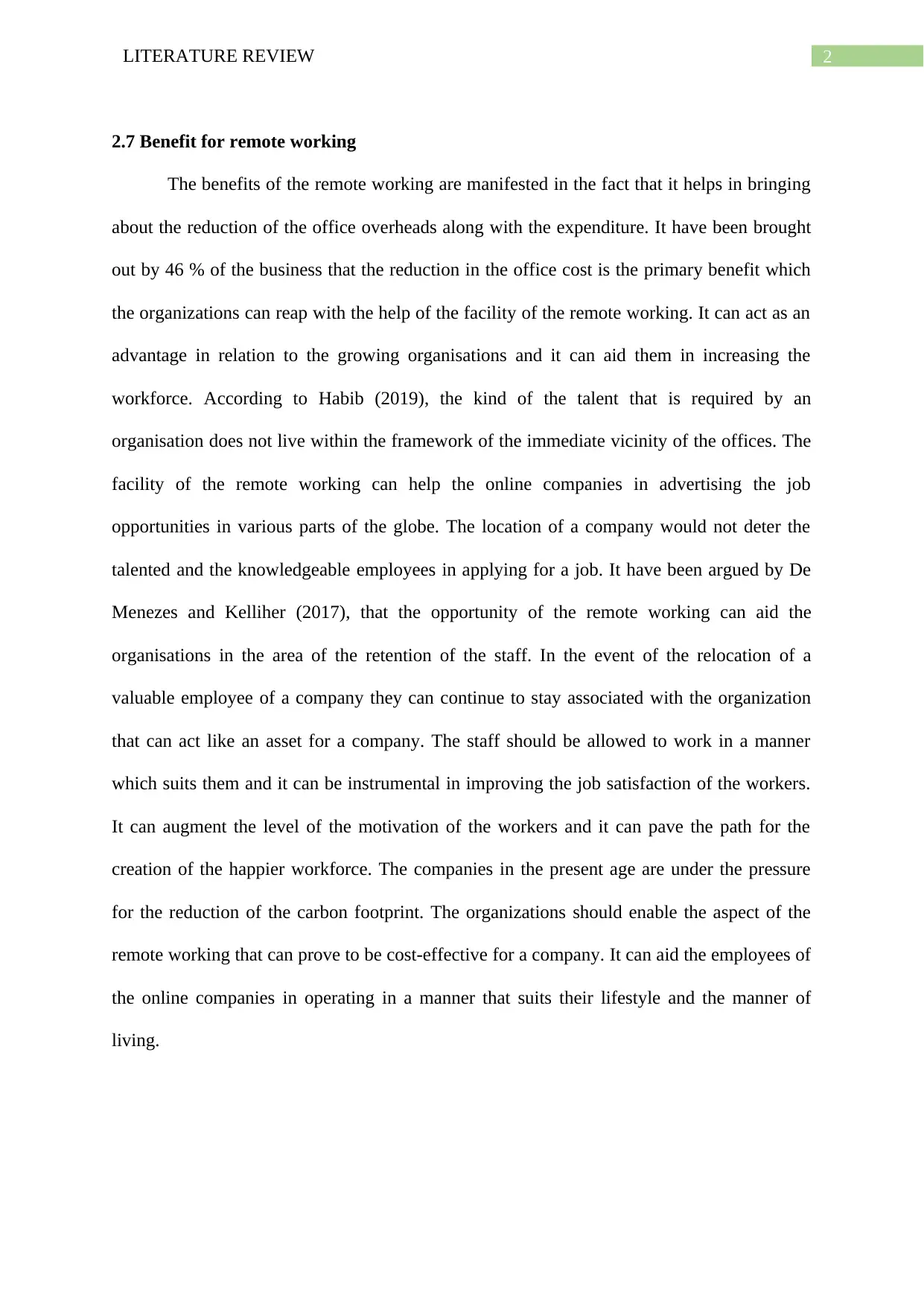
2LITERATURE REVIEW
2.7 Benefit for remote working
The benefits of the remote working are manifested in the fact that it helps in bringing
about the reduction of the office overheads along with the expenditure. It have been brought
out by 46 % of the business that the reduction in the office cost is the primary benefit which
the organizations can reap with the help of the facility of the remote working. It can act as an
advantage in relation to the growing organisations and it can aid them in increasing the
workforce. According to Habib (2019), the kind of the talent that is required by an
organisation does not live within the framework of the immediate vicinity of the offices. The
facility of the remote working can help the online companies in advertising the job
opportunities in various parts of the globe. The location of a company would not deter the
talented and the knowledgeable employees in applying for a job. It have been argued by De
Menezes and Kelliher (2017), that the opportunity of the remote working can aid the
organisations in the area of the retention of the staff. In the event of the relocation of a
valuable employee of a company they can continue to stay associated with the organization
that can act like an asset for a company. The staff should be allowed to work in a manner
which suits them and it can be instrumental in improving the job satisfaction of the workers.
It can augment the level of the motivation of the workers and it can pave the path for the
creation of the happier workforce. The companies in the present age are under the pressure
for the reduction of the carbon footprint. The organizations should enable the aspect of the
remote working that can prove to be cost-effective for a company. It can aid the employees of
the online companies in operating in a manner that suits their lifestyle and the manner of
living.
2.7 Benefit for remote working
The benefits of the remote working are manifested in the fact that it helps in bringing
about the reduction of the office overheads along with the expenditure. It have been brought
out by 46 % of the business that the reduction in the office cost is the primary benefit which
the organizations can reap with the help of the facility of the remote working. It can act as an
advantage in relation to the growing organisations and it can aid them in increasing the
workforce. According to Habib (2019), the kind of the talent that is required by an
organisation does not live within the framework of the immediate vicinity of the offices. The
facility of the remote working can help the online companies in advertising the job
opportunities in various parts of the globe. The location of a company would not deter the
talented and the knowledgeable employees in applying for a job. It have been argued by De
Menezes and Kelliher (2017), that the opportunity of the remote working can aid the
organisations in the area of the retention of the staff. In the event of the relocation of a
valuable employee of a company they can continue to stay associated with the organization
that can act like an asset for a company. The staff should be allowed to work in a manner
which suits them and it can be instrumental in improving the job satisfaction of the workers.
It can augment the level of the motivation of the workers and it can pave the path for the
creation of the happier workforce. The companies in the present age are under the pressure
for the reduction of the carbon footprint. The organizations should enable the aspect of the
remote working that can prove to be cost-effective for a company. It can aid the employees of
the online companies in operating in a manner that suits their lifestyle and the manner of
living.
⊘ This is a preview!⊘
Do you want full access?
Subscribe today to unlock all pages.

Trusted by 1+ million students worldwide
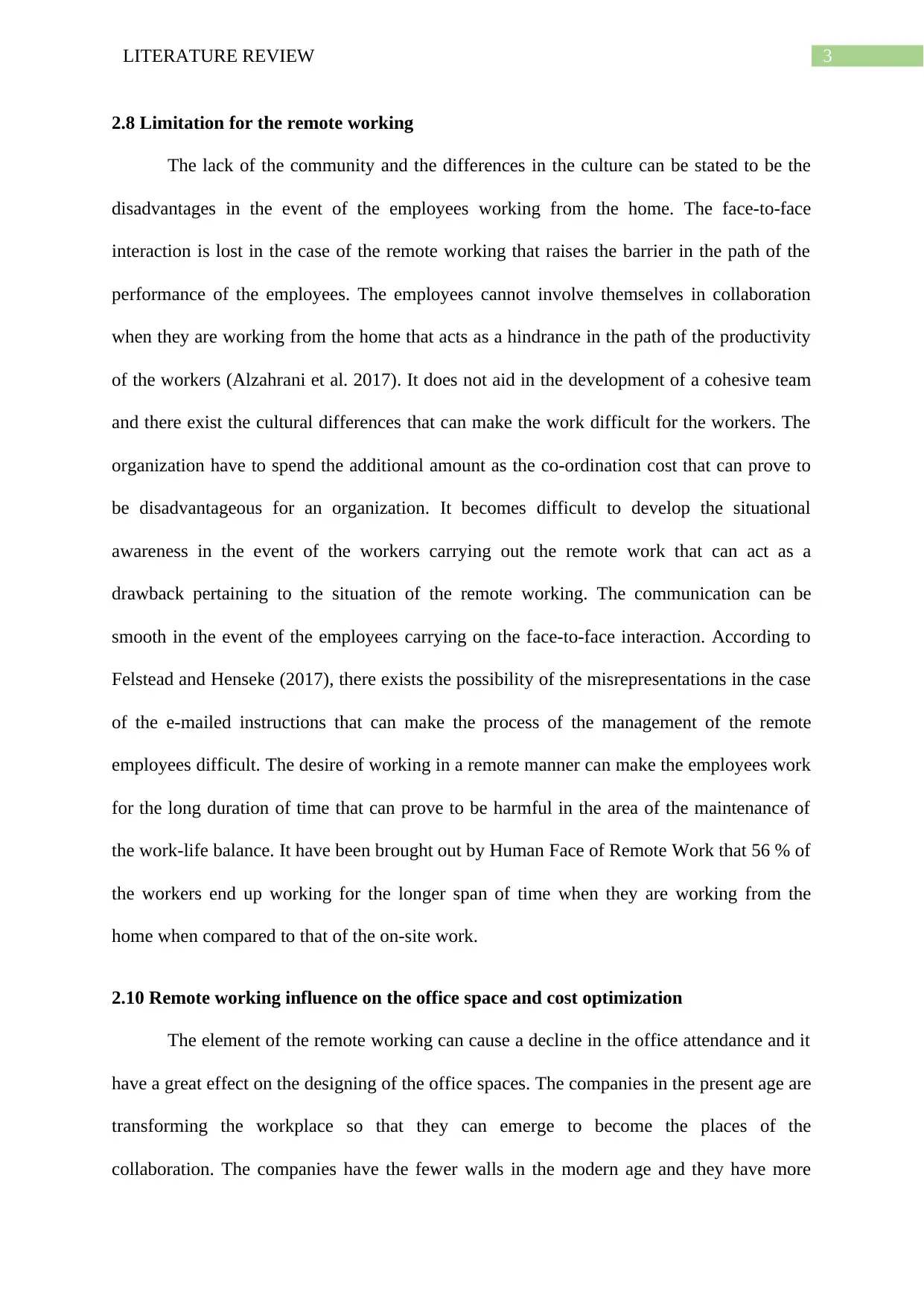
3LITERATURE REVIEW
2.8 Limitation for the remote working
The lack of the community and the differences in the culture can be stated to be the
disadvantages in the event of the employees working from the home. The face-to-face
interaction is lost in the case of the remote working that raises the barrier in the path of the
performance of the employees. The employees cannot involve themselves in collaboration
when they are working from the home that acts as a hindrance in the path of the productivity
of the workers (Alzahrani et al. 2017). It does not aid in the development of a cohesive team
and there exist the cultural differences that can make the work difficult for the workers. The
organization have to spend the additional amount as the co-ordination cost that can prove to
be disadvantageous for an organization. It becomes difficult to develop the situational
awareness in the event of the workers carrying out the remote work that can act as a
drawback pertaining to the situation of the remote working. The communication can be
smooth in the event of the employees carrying on the face-to-face interaction. According to
Felstead and Henseke (2017), there exists the possibility of the misrepresentations in the case
of the e-mailed instructions that can make the process of the management of the remote
employees difficult. The desire of working in a remote manner can make the employees work
for the long duration of time that can prove to be harmful in the area of the maintenance of
the work-life balance. It have been brought out by Human Face of Remote Work that 56 % of
the workers end up working for the longer span of time when they are working from the
home when compared to that of the on-site work.
2.10 Remote working influence on the office space and cost optimization
The element of the remote working can cause a decline in the office attendance and it
have a great effect on the designing of the office spaces. The companies in the present age are
transforming the workplace so that they can emerge to become the places of the
collaboration. The companies have the fewer walls in the modern age and they have more
2.8 Limitation for the remote working
The lack of the community and the differences in the culture can be stated to be the
disadvantages in the event of the employees working from the home. The face-to-face
interaction is lost in the case of the remote working that raises the barrier in the path of the
performance of the employees. The employees cannot involve themselves in collaboration
when they are working from the home that acts as a hindrance in the path of the productivity
of the workers (Alzahrani et al. 2017). It does not aid in the development of a cohesive team
and there exist the cultural differences that can make the work difficult for the workers. The
organization have to spend the additional amount as the co-ordination cost that can prove to
be disadvantageous for an organization. It becomes difficult to develop the situational
awareness in the event of the workers carrying out the remote work that can act as a
drawback pertaining to the situation of the remote working. The communication can be
smooth in the event of the employees carrying on the face-to-face interaction. According to
Felstead and Henseke (2017), there exists the possibility of the misrepresentations in the case
of the e-mailed instructions that can make the process of the management of the remote
employees difficult. The desire of working in a remote manner can make the employees work
for the long duration of time that can prove to be harmful in the area of the maintenance of
the work-life balance. It have been brought out by Human Face of Remote Work that 56 % of
the workers end up working for the longer span of time when they are working from the
home when compared to that of the on-site work.
2.10 Remote working influence on the office space and cost optimization
The element of the remote working can cause a decline in the office attendance and it
have a great effect on the designing of the office spaces. The companies in the present age are
transforming the workplace so that they can emerge to become the places of the
collaboration. The companies have the fewer walls in the modern age and they have more
Paraphrase This Document
Need a fresh take? Get an instant paraphrase of this document with our AI Paraphraser

4LITERATURE REVIEW
number of the meeting spaces in the modern age of the remote working. There are four kinds
of space that are necessary for the office in present age: focus space, space for the private
conversation, social space along with the collaborative space. The allocation of these spaces
within the framework of the physical environment can make the office feel like the home that
can bring about an improvement in the productivity of the workers (Hunter 2019). The people
are making the investment in the aspect of the comfort along with the luxury of the homes as
they spend a great deal of time within the framework of their homes. The people are making
use of the residential approach pertaining to the office design so that it can make the workers
feel comfortable within the ambit of the workplace. It have been brought out with the help of
the research that the unscheduled absences can cost the employers a great deal of money.
According to Sherman (2019), it can aid in cutting down on the payroll costs as there are a
large number of the professionals who would be willing to get the opportunity of working
remotely instead of getting the pay raise. It can decrease the turnover of the employees by
around 25 % that can save the companies a great amount of the money. It have a great effect
on the aspect of the employee retention that can cut down on the turnover cost of the workers.
2.11 Role of the engagement for the workers working remotely
The remote working is growing in the popularity in the present age and the
engagement can prove to be crucial for the workers who are carrying out the work in the
remote fashion. The remote working can isolate the staff and it can have the residual effect on
the aspect of the team performance. The remote working can be said to be less connected to
the central company base and it can bring down the engagement level of the employees.
According to Sharp et al. (2016), that the virtual face-to-face meetings should be carried out
that can increase the engagement among the employees. The communication tools can be
employed by a company that can provide encouragement to the workers. It have been brought
out by Ramakrishnan and Arokiasamy (2019), that the video conferencing tools can be made
number of the meeting spaces in the modern age of the remote working. There are four kinds
of space that are necessary for the office in present age: focus space, space for the private
conversation, social space along with the collaborative space. The allocation of these spaces
within the framework of the physical environment can make the office feel like the home that
can bring about an improvement in the productivity of the workers (Hunter 2019). The people
are making the investment in the aspect of the comfort along with the luxury of the homes as
they spend a great deal of time within the framework of their homes. The people are making
use of the residential approach pertaining to the office design so that it can make the workers
feel comfortable within the ambit of the workplace. It have been brought out with the help of
the research that the unscheduled absences can cost the employers a great deal of money.
According to Sherman (2019), it can aid in cutting down on the payroll costs as there are a
large number of the professionals who would be willing to get the opportunity of working
remotely instead of getting the pay raise. It can decrease the turnover of the employees by
around 25 % that can save the companies a great amount of the money. It have a great effect
on the aspect of the employee retention that can cut down on the turnover cost of the workers.
2.11 Role of the engagement for the workers working remotely
The remote working is growing in the popularity in the present age and the
engagement can prove to be crucial for the workers who are carrying out the work in the
remote fashion. The remote working can isolate the staff and it can have the residual effect on
the aspect of the team performance. The remote working can be said to be less connected to
the central company base and it can bring down the engagement level of the employees.
According to Sharp et al. (2016), that the virtual face-to-face meetings should be carried out
that can increase the engagement among the employees. The communication tools can be
employed by a company that can provide encouragement to the workers. It have been brought
out by Ramakrishnan and Arokiasamy (2019), that the video conferencing tools can be made
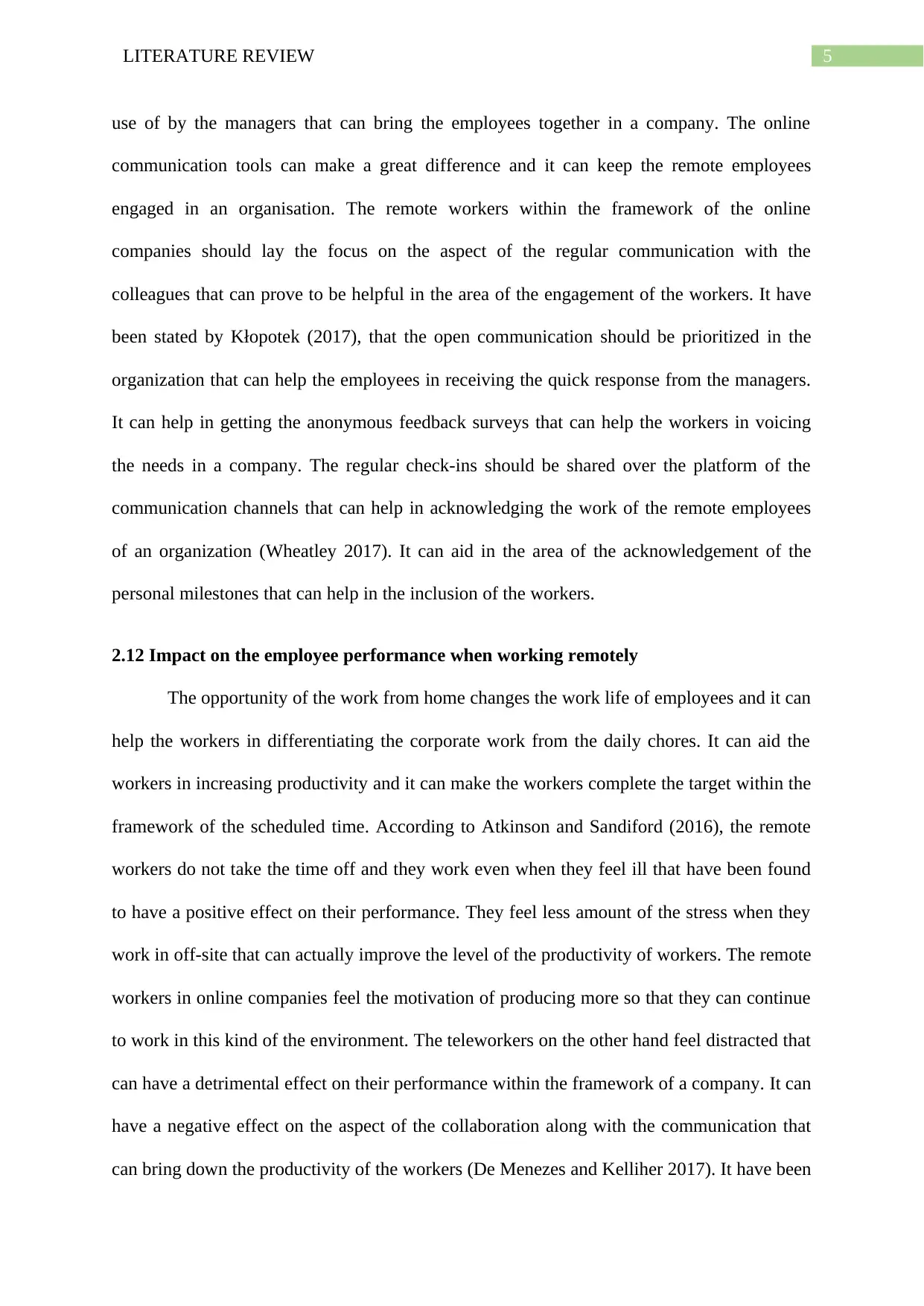
5LITERATURE REVIEW
use of by the managers that can bring the employees together in a company. The online
communication tools can make a great difference and it can keep the remote employees
engaged in an organisation. The remote workers within the framework of the online
companies should lay the focus on the aspect of the regular communication with the
colleagues that can prove to be helpful in the area of the engagement of the workers. It have
been stated by Kłopotek (2017), that the open communication should be prioritized in the
organization that can help the employees in receiving the quick response from the managers.
It can help in getting the anonymous feedback surveys that can help the workers in voicing
the needs in a company. The regular check-ins should be shared over the platform of the
communication channels that can help in acknowledging the work of the remote employees
of an organization (Wheatley 2017). It can aid in the area of the acknowledgement of the
personal milestones that can help in the inclusion of the workers.
2.12 Impact on the employee performance when working remotely
The opportunity of the work from home changes the work life of employees and it can
help the workers in differentiating the corporate work from the daily chores. It can aid the
workers in increasing productivity and it can make the workers complete the target within the
framework of the scheduled time. According to Atkinson and Sandiford (2016), the remote
workers do not take the time off and they work even when they feel ill that have been found
to have a positive effect on their performance. They feel less amount of the stress when they
work in off-site that can actually improve the level of the productivity of workers. The remote
workers in online companies feel the motivation of producing more so that they can continue
to work in this kind of the environment. The teleworkers on the other hand feel distracted that
can have a detrimental effect on their performance within the framework of a company. It can
have a negative effect on the aspect of the collaboration along with the communication that
can bring down the productivity of the workers (De Menezes and Kelliher 2017). It have been
use of by the managers that can bring the employees together in a company. The online
communication tools can make a great difference and it can keep the remote employees
engaged in an organisation. The remote workers within the framework of the online
companies should lay the focus on the aspect of the regular communication with the
colleagues that can prove to be helpful in the area of the engagement of the workers. It have
been stated by Kłopotek (2017), that the open communication should be prioritized in the
organization that can help the employees in receiving the quick response from the managers.
It can help in getting the anonymous feedback surveys that can help the workers in voicing
the needs in a company. The regular check-ins should be shared over the platform of the
communication channels that can help in acknowledging the work of the remote employees
of an organization (Wheatley 2017). It can aid in the area of the acknowledgement of the
personal milestones that can help in the inclusion of the workers.
2.12 Impact on the employee performance when working remotely
The opportunity of the work from home changes the work life of employees and it can
help the workers in differentiating the corporate work from the daily chores. It can aid the
workers in increasing productivity and it can make the workers complete the target within the
framework of the scheduled time. According to Atkinson and Sandiford (2016), the remote
workers do not take the time off and they work even when they feel ill that have been found
to have a positive effect on their performance. They feel less amount of the stress when they
work in off-site that can actually improve the level of the productivity of workers. The remote
workers in online companies feel the motivation of producing more so that they can continue
to work in this kind of the environment. The teleworkers on the other hand feel distracted that
can have a detrimental effect on their performance within the framework of a company. It can
have a negative effect on the aspect of the collaboration along with the communication that
can bring down the productivity of the workers (De Menezes and Kelliher 2017). It have been
⊘ This is a preview!⊘
Do you want full access?
Subscribe today to unlock all pages.

Trusted by 1+ million students worldwide
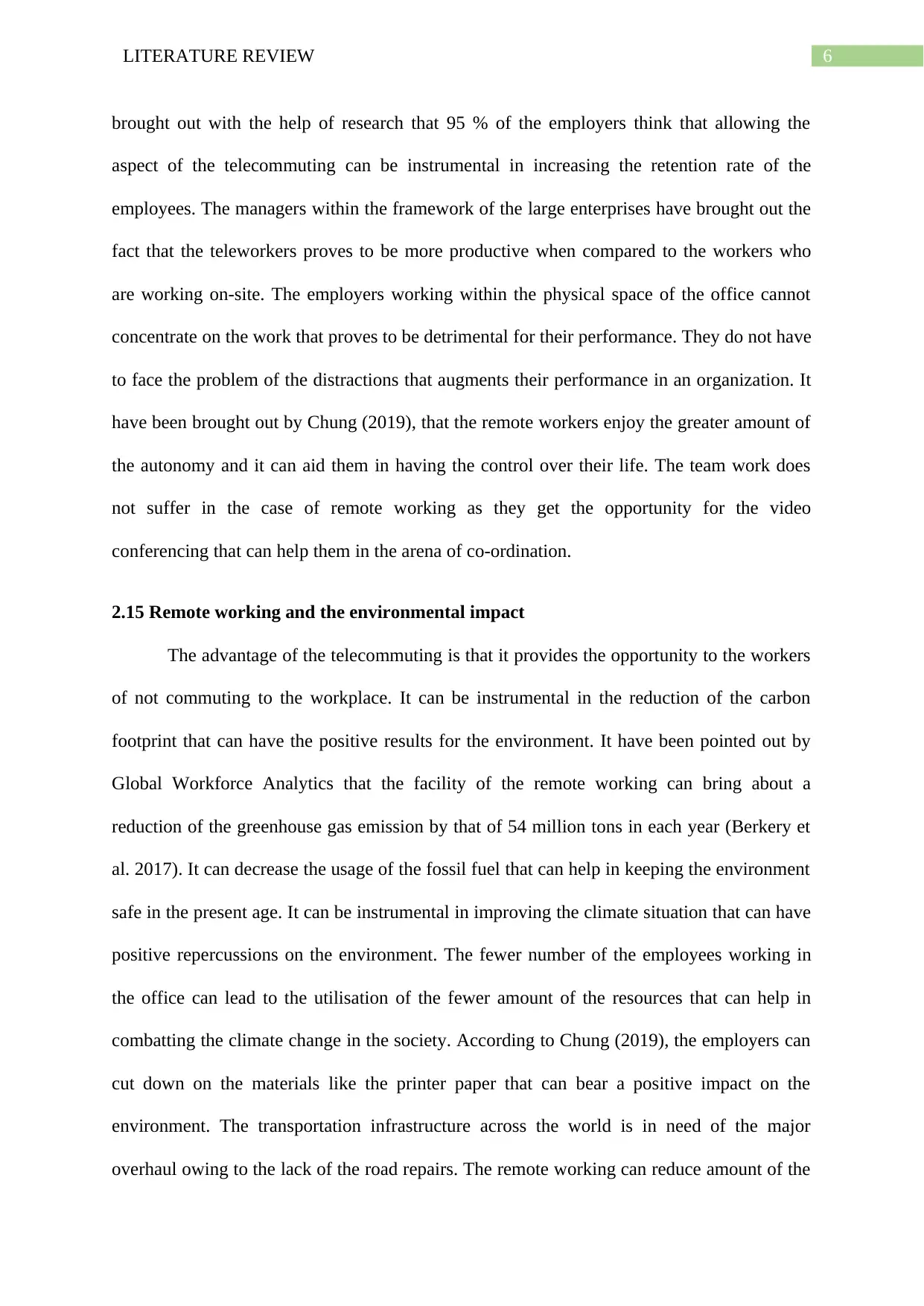
6LITERATURE REVIEW
brought out with the help of research that 95 % of the employers think that allowing the
aspect of the telecommuting can be instrumental in increasing the retention rate of the
employees. The managers within the framework of the large enterprises have brought out the
fact that the teleworkers proves to be more productive when compared to the workers who
are working on-site. The employers working within the physical space of the office cannot
concentrate on the work that proves to be detrimental for their performance. They do not have
to face the problem of the distractions that augments their performance in an organization. It
have been brought out by Chung (2019), that the remote workers enjoy the greater amount of
the autonomy and it can aid them in having the control over their life. The team work does
not suffer in the case of remote working as they get the opportunity for the video
conferencing that can help them in the arena of co-ordination.
2.15 Remote working and the environmental impact
The advantage of the telecommuting is that it provides the opportunity to the workers
of not commuting to the workplace. It can be instrumental in the reduction of the carbon
footprint that can have the positive results for the environment. It have been pointed out by
Global Workforce Analytics that the facility of the remote working can bring about a
reduction of the greenhouse gas emission by that of 54 million tons in each year (Berkery et
al. 2017). It can decrease the usage of the fossil fuel that can help in keeping the environment
safe in the present age. It can be instrumental in improving the climate situation that can have
positive repercussions on the environment. The fewer number of the employees working in
the office can lead to the utilisation of the fewer amount of the resources that can help in
combatting the climate change in the society. According to Chung (2019), the employers can
cut down on the materials like the printer paper that can bear a positive impact on the
environment. The transportation infrastructure across the world is in need of the major
overhaul owing to the lack of the road repairs. The remote working can reduce amount of the
brought out with the help of research that 95 % of the employers think that allowing the
aspect of the telecommuting can be instrumental in increasing the retention rate of the
employees. The managers within the framework of the large enterprises have brought out the
fact that the teleworkers proves to be more productive when compared to the workers who
are working on-site. The employers working within the physical space of the office cannot
concentrate on the work that proves to be detrimental for their performance. They do not have
to face the problem of the distractions that augments their performance in an organization. It
have been brought out by Chung (2019), that the remote workers enjoy the greater amount of
the autonomy and it can aid them in having the control over their life. The team work does
not suffer in the case of remote working as they get the opportunity for the video
conferencing that can help them in the arena of co-ordination.
2.15 Remote working and the environmental impact
The advantage of the telecommuting is that it provides the opportunity to the workers
of not commuting to the workplace. It can be instrumental in the reduction of the carbon
footprint that can have the positive results for the environment. It have been pointed out by
Global Workforce Analytics that the facility of the remote working can bring about a
reduction of the greenhouse gas emission by that of 54 million tons in each year (Berkery et
al. 2017). It can decrease the usage of the fossil fuel that can help in keeping the environment
safe in the present age. It can be instrumental in improving the climate situation that can have
positive repercussions on the environment. The fewer number of the employees working in
the office can lead to the utilisation of the fewer amount of the resources that can help in
combatting the climate change in the society. According to Chung (2019), the employers can
cut down on the materials like the printer paper that can bear a positive impact on the
environment. The transportation infrastructure across the world is in need of the major
overhaul owing to the lack of the road repairs. The remote working can reduce amount of the
Paraphrase This Document
Need a fresh take? Get an instant paraphrase of this document with our AI Paraphraser
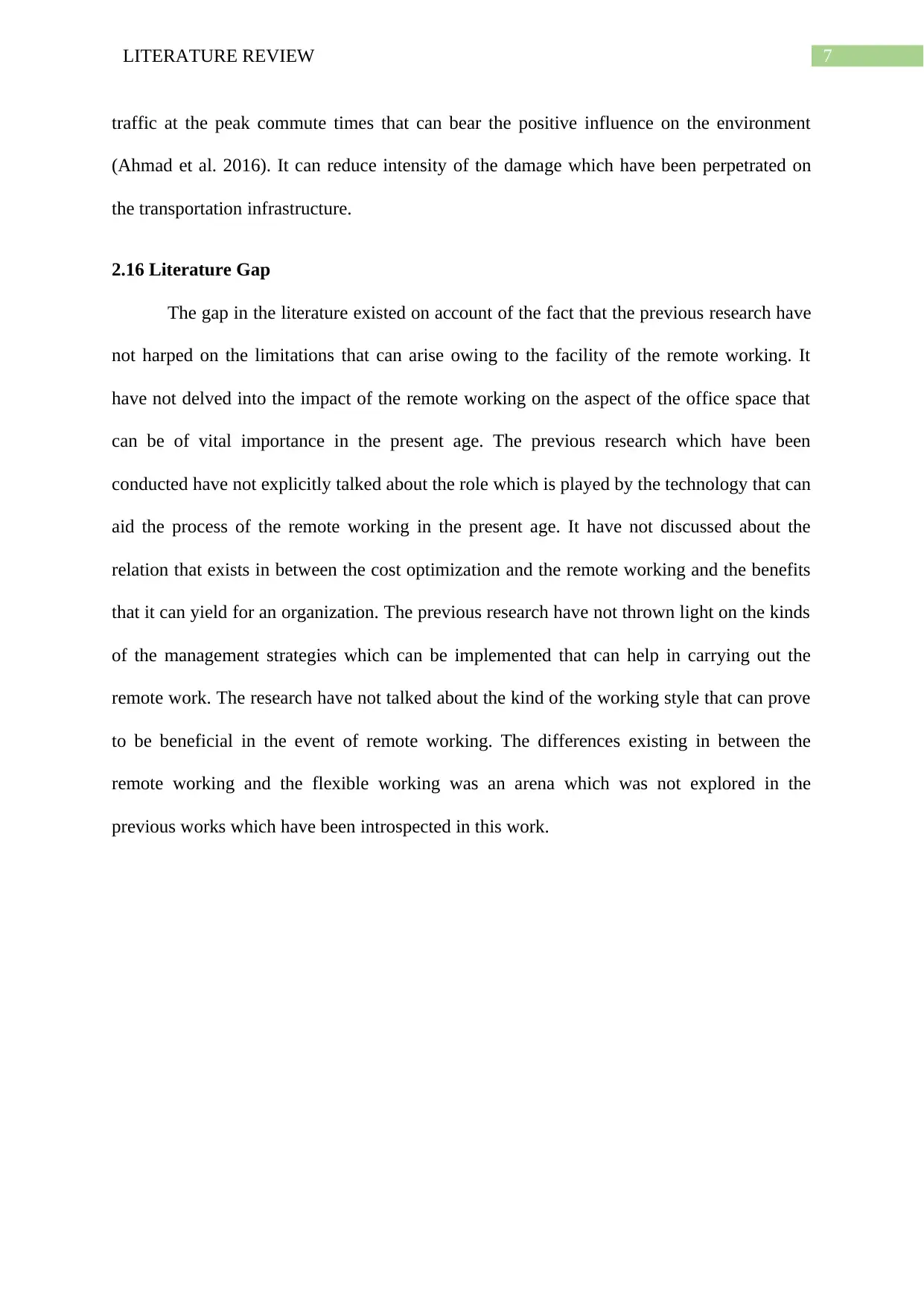
7LITERATURE REVIEW
traffic at the peak commute times that can bear the positive influence on the environment
(Ahmad et al. 2016). It can reduce intensity of the damage which have been perpetrated on
the transportation infrastructure.
2.16 Literature Gap
The gap in the literature existed on account of the fact that the previous research have
not harped on the limitations that can arise owing to the facility of the remote working. It
have not delved into the impact of the remote working on the aspect of the office space that
can be of vital importance in the present age. The previous research which have been
conducted have not explicitly talked about the role which is played by the technology that can
aid the process of the remote working in the present age. It have not discussed about the
relation that exists in between the cost optimization and the remote working and the benefits
that it can yield for an organization. The previous research have not thrown light on the kinds
of the management strategies which can be implemented that can help in carrying out the
remote work. The research have not talked about the kind of the working style that can prove
to be beneficial in the event of remote working. The differences existing in between the
remote working and the flexible working was an arena which was not explored in the
previous works which have been introspected in this work.
traffic at the peak commute times that can bear the positive influence on the environment
(Ahmad et al. 2016). It can reduce intensity of the damage which have been perpetrated on
the transportation infrastructure.
2.16 Literature Gap
The gap in the literature existed on account of the fact that the previous research have
not harped on the limitations that can arise owing to the facility of the remote working. It
have not delved into the impact of the remote working on the aspect of the office space that
can be of vital importance in the present age. The previous research which have been
conducted have not explicitly talked about the role which is played by the technology that can
aid the process of the remote working in the present age. It have not discussed about the
relation that exists in between the cost optimization and the remote working and the benefits
that it can yield for an organization. The previous research have not thrown light on the kinds
of the management strategies which can be implemented that can help in carrying out the
remote work. The research have not talked about the kind of the working style that can prove
to be beneficial in the event of remote working. The differences existing in between the
remote working and the flexible working was an arena which was not explored in the
previous works which have been introspected in this work.

8LITERATURE REVIEW
References
Ahmad, A., Shaw, N.E., Bown, N.J., Gardiner, J. and Omar, K., 2016. The impact of negative
work home interface on intention to leave and the role of flexible working arrangements in
Malaysia. The Journal of Developing Areas, 50(5), pp.507-515.
Alzahrani, A., Alkhafaji, A., Kula, K., Zaid, M. and Karami, N., 2017. The Effects of Remote
Work on Team Building.
Atkinson, C. and Sandiford, P., 2016. An exploration of older worker flexible working
arrangements in smaller firms. Human Resource Management Journal, 26(1), pp.12-28.
Berkery, E., Morley, M.J., Tiernan, S., Purtill, H. and Parry, E., 2017. On the uptake of
flexible working arrangements and the association with human resource and organizational
performance outcomes. European Management Review, 14(2), pp.165-183.
Chung, H., 2019. ‘Women’s work penalty’in access to flexible working arrangements across
Europe. European Journal of Industrial Relations, 25(1), pp.23-40.
Chung, H., 2019. Part-time working women’s access to other types of flexible working-time
arrangements across Europe. Dualisation of Part-Time Work: The Development of Labour
Market Insiders and Outsiders, p.109.
De Menezes, L.M. and Kelliher, C., 2017. Flexible working, individual performance, and
employee attitudes: Comparing formal and informal arrangements. Human Resource
Management, 56(6), pp.1051-1070.
De Menezes, L.M. and Kelliher, C., 2017. Flexible working, individual performance, and
employee attitudes: Comparing formal and informal arrangements. Human Resource
Management, 56(6), pp.1051-1070.
References
Ahmad, A., Shaw, N.E., Bown, N.J., Gardiner, J. and Omar, K., 2016. The impact of negative
work home interface on intention to leave and the role of flexible working arrangements in
Malaysia. The Journal of Developing Areas, 50(5), pp.507-515.
Alzahrani, A., Alkhafaji, A., Kula, K., Zaid, M. and Karami, N., 2017. The Effects of Remote
Work on Team Building.
Atkinson, C. and Sandiford, P., 2016. An exploration of older worker flexible working
arrangements in smaller firms. Human Resource Management Journal, 26(1), pp.12-28.
Berkery, E., Morley, M.J., Tiernan, S., Purtill, H. and Parry, E., 2017. On the uptake of
flexible working arrangements and the association with human resource and organizational
performance outcomes. European Management Review, 14(2), pp.165-183.
Chung, H., 2019. ‘Women’s work penalty’in access to flexible working arrangements across
Europe. European Journal of Industrial Relations, 25(1), pp.23-40.
Chung, H., 2019. Part-time working women’s access to other types of flexible working-time
arrangements across Europe. Dualisation of Part-Time Work: The Development of Labour
Market Insiders and Outsiders, p.109.
De Menezes, L.M. and Kelliher, C., 2017. Flexible working, individual performance, and
employee attitudes: Comparing formal and informal arrangements. Human Resource
Management, 56(6), pp.1051-1070.
De Menezes, L.M. and Kelliher, C., 2017. Flexible working, individual performance, and
employee attitudes: Comparing formal and informal arrangements. Human Resource
Management, 56(6), pp.1051-1070.
⊘ This is a preview!⊘
Do you want full access?
Subscribe today to unlock all pages.

Trusted by 1+ million students worldwide
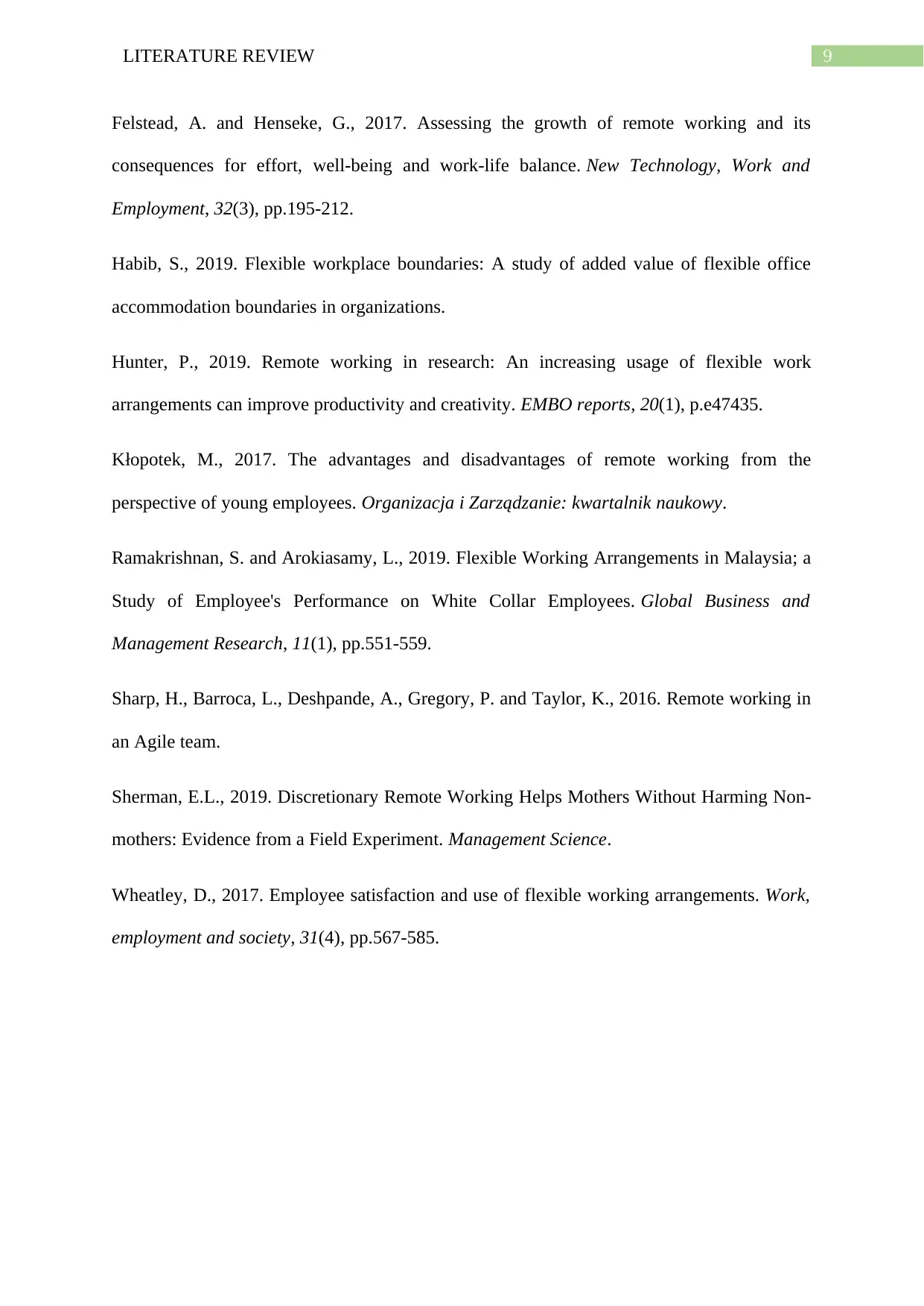
9LITERATURE REVIEW
Felstead, A. and Henseke, G., 2017. Assessing the growth of remote working and its
consequences for effort, well‐being and work‐life balance. New Technology, Work and
Employment, 32(3), pp.195-212.
Habib, S., 2019. Flexible workplace boundaries: A study of added value of flexible office
accommodation boundaries in organizations.
Hunter, P., 2019. Remote working in research: An increasing usage of flexible work
arrangements can improve productivity and creativity. EMBO reports, 20(1), p.e47435.
Kłopotek, M., 2017. The advantages and disadvantages of remote working from the
perspective of young employees. Organizacja i Zarządzanie: kwartalnik naukowy.
Ramakrishnan, S. and Arokiasamy, L., 2019. Flexible Working Arrangements in Malaysia; a
Study of Employee's Performance on White Collar Employees. Global Business and
Management Research, 11(1), pp.551-559.
Sharp, H., Barroca, L., Deshpande, A., Gregory, P. and Taylor, K., 2016. Remote working in
an Agile team.
Sherman, E.L., 2019. Discretionary Remote Working Helps Mothers Without Harming Non-
mothers: Evidence from a Field Experiment. Management Science.
Wheatley, D., 2017. Employee satisfaction and use of flexible working arrangements. Work,
employment and society, 31(4), pp.567-585.
Felstead, A. and Henseke, G., 2017. Assessing the growth of remote working and its
consequences for effort, well‐being and work‐life balance. New Technology, Work and
Employment, 32(3), pp.195-212.
Habib, S., 2019. Flexible workplace boundaries: A study of added value of flexible office
accommodation boundaries in organizations.
Hunter, P., 2019. Remote working in research: An increasing usage of flexible work
arrangements can improve productivity and creativity. EMBO reports, 20(1), p.e47435.
Kłopotek, M., 2017. The advantages and disadvantages of remote working from the
perspective of young employees. Organizacja i Zarządzanie: kwartalnik naukowy.
Ramakrishnan, S. and Arokiasamy, L., 2019. Flexible Working Arrangements in Malaysia; a
Study of Employee's Performance on White Collar Employees. Global Business and
Management Research, 11(1), pp.551-559.
Sharp, H., Barroca, L., Deshpande, A., Gregory, P. and Taylor, K., 2016. Remote working in
an Agile team.
Sherman, E.L., 2019. Discretionary Remote Working Helps Mothers Without Harming Non-
mothers: Evidence from a Field Experiment. Management Science.
Wheatley, D., 2017. Employee satisfaction and use of flexible working arrangements. Work,
employment and society, 31(4), pp.567-585.
1 out of 10
Related Documents
Your All-in-One AI-Powered Toolkit for Academic Success.
+13062052269
info@desklib.com
Available 24*7 on WhatsApp / Email
![[object Object]](/_next/static/media/star-bottom.7253800d.svg)
Unlock your academic potential
Copyright © 2020–2025 A2Z Services. All Rights Reserved. Developed and managed by ZUCOL.




